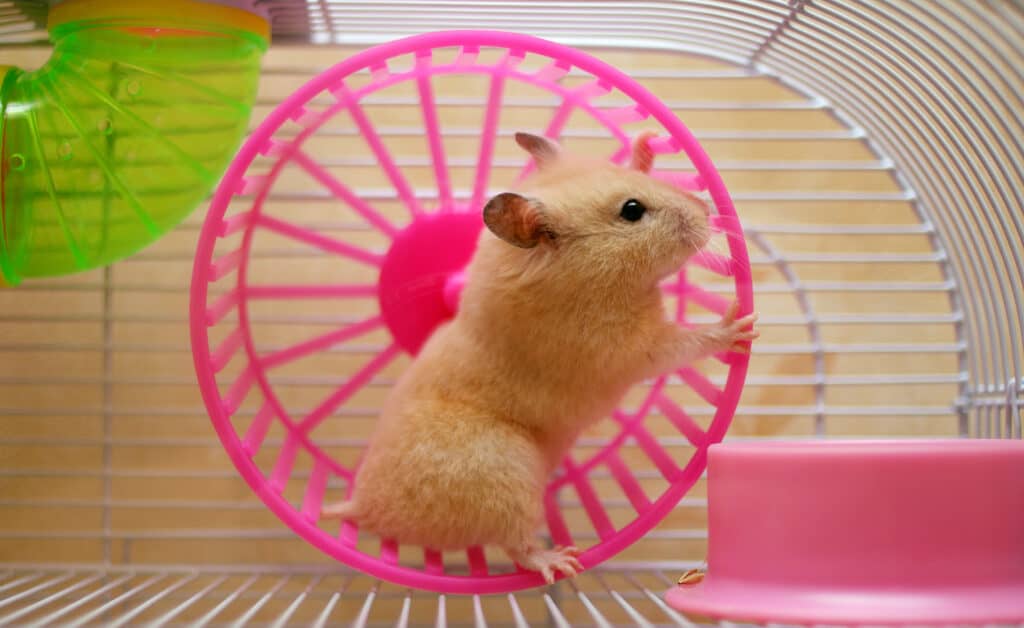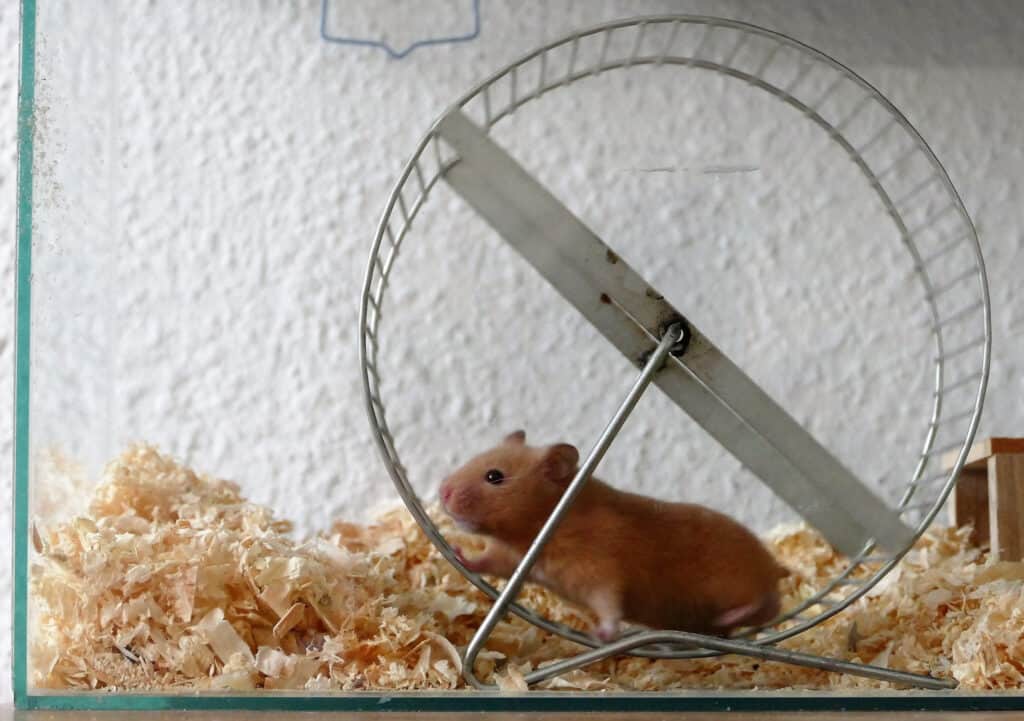If you recently brought a new hamster home, you may be searching for the perfect exercise wheel. Maybe you need help choosing the correct wheel for your little buddy. Or maybe you bought the wrong hamster wheel and need to choose a more suitable option. In either case, this article will help clear up any confusion and misconceptions.
Hamster wheels are an essential item for all hamsters. Your little pet should have access to a safe wheel that is right for his size. There are many different wheels on the market; however, not all of them are safe or recommended for hamsters. Just because a hamster wheel is marketed toward hamsters, does not mean that it is safe for them to use.
Providing the right wheel type and size is important, as hamsters spend most of the night running to release energy.
Do Hamsters Need Wheels?
In the wild, hamsters can run up to eight miles per night in search of food, territory, and mates. They are active creatures that enjoy running and exploring their environment. It is important to provide your hamster with the right wheel, along with a large cage full of enrichment.
In captivity, it is difficult to provide a habitat large enough for your buddy to run the distance he would in the wild. For this reason, wheels are necessary. Without this exercise outlet, your hamster can become bored and feel stressed from being cooped up.
Hamsters run on the wheel throughout the night, as they are nocturnal or crepuscular. The smaller the cage, the more time the hamster will run.
Free roaming your hamster in a safe environment or handling him should not replace an exercise wheel. Even though these activities are a form of exercise, hamsters still need an exercise wheel in the cage.
Why Does Size Matter?
You may have heard that hamsters need very large wheels, which may be confusing if you do not understand why. Many hamsters’ owners struggle to fit a large wheel into their hamster’s cage because the cage is too small to support the wheel size your hamster needs, which is why it is important that your hamster has a large cage (600-850 square inches minimum).
Hamster wheel size is important because if your hamster’s wheel is too small then their backs will start to arch. This can make running on the wheel very uncomfortable for your hamster, which can lead to spinal abnormalities, back pain, or cause your hamster to not use the wheel because they are too uncomfortable. Since hamsters spend so much time on their wheels, imagine how uncomfortable it may be to have to constantly arch their backs to run.
The pain of trying to run on a small wheel can make their running posture uncomfortable, which is why so many hamsters will not run on their wheels if it is too small. So, if you have a hamster that is not running on its wheel, you may need to consider if the size and type of wheel are right to eliminate any discomfort.

This hamster wheel is far too small and will cause this hamster’s back to curve backwards into a “C” shape.
©AlexKalashnikov/Shutterstock.com
Suitable and Unsuitable Hamster Wheels
There are many unsuitable hamster wheels sold in the market, which makes it important to familiarize yourself with the types of wheels that you should be providing your hamster with. Some hamster cages will come with a wheel that is too small, and many of the wheels you find in a pet store may be too small or are unsuitable for hamsters.
Suitable
Flat surface running wheels are the safest options for hamsters. These types of wheels have a smooth-running surface with no bars or mesh and are generally made from plastic, wood, or acrylic. However, not all flat surfaced wheel is safe as some of them will be too small for hamsters. The wheel itself should have no cross bars or spindles sticking out which could affect your hamster’s running posture. You want to choose a wheel that is at least over 8 inches (20 cm) in size as a minimum.
Unsuitable
The unsuitable and potentially dangerous hamster wheels are small and do not have a flat, continuous running surface. Instead, the wheel may be made from metal and have a mesh or barred running surface. Even if the wheel itself is large, the wheel is unsafe. This is because the barred and mesh surface is uncomfortable for your hamsters’ feet.
Your hamster may even get its leg or paw stuck in the wheel which can lead to injury. Mesh and barred wheels have also been associated with hamsters developing bumblefoot, which inflammation of their paw pads. The bars and mesh can cause open wounds in your hamster’s paw pads, which puts them at risk of developing a bacterial infection that can be severe and painful.
What Types of Hamster Wheels Are There? Pros and Cons Discussed
Let’s look at the different hamster wheels available on the market:
Flat-Surface Upright Hamster Wheels
These wheels come in different sizes, colors, and designs and have a flat and continuous running surface. Some wheels will come with slight ridges that your hamster can use for gripping when they run. These are the safest hamster wheel if they are the right size. These wheels can be wooden or be designed to be super silent when your hamster runs on them.
| Pros | Cons |
|---|---|
| Comes in a variety of different colors, sizes, and designs | May be pricey |
| Considered to be a safe and suitable wheel | |
| Large size options are available |
Flying Saucers or Disk Hamster Wheels
These are flat running wheels that have a flat, disk shape. They cannot be attached to the side of the cage, and they have a bowl-like shape. These wheels are safe for hamsters as they have a flat running surface, however, you will need to purchase a large flying saucer hamster wheel so that your hamster’s back does not curve sideways when they are running. These wheels can be used in shallow hamster cages where there is not enough space between the bedding and the top of the cage to fit a large upright wheel inside.
If you choose to purchase a flying saucer hamster wheel, then the 11-to-12-inch (27-30 cm) size option is recommended for all species.
| Pros | Cons |
|---|---|
| Comes in different colors and sizes | Only the large sizes are suitable |
| Safe for hamsters | |
| Suitable for shallow hamster cages |
Barred Hamster Wheels
An unsuitable hamster wheel that is typically made of metal or plastic with horizontal bars as the running surface. They are generally cheap and can come in large sizes, however, they are not suitable for hamsters regardless of the size.
| Pros | Cons |
|---|---|
| Affordable | Not suitable for hamsters because of the barred running surface |
| Easily accessible in pet stores | Puts your hamster at risk of injury or bumblefoot |
| Comes in different colors and designs |
Mesh Hamster Wheels
The running surface will consist of small, meshed squares. These wheels can come in a variety of different colors and sizes; however, the running surface is unsuitable for hamsters and puts them at risk of developing bumblefoot or getting their paws stuck in the mesh and getting injured.
| Pros | Cons |
|---|---|
| Easily accessible in pet stores | Difficult to clean |
| Available in different colors and sizes | Can cause injuries to your hamsters’ paws |
Signs Your Hamsters Wheel Is Too Small
If you are wondering if your hamster’s wheel is too small for your little guy, look for these signs:
- His back forms a ‘C’ shape when running.
- He cannot straighten his body on the wheel.
- He has difficulty running with a good posture.
- He refuses to use the wheel or only uses it for a short amount of time.
- He struggles to push the wheel even if it is not heavy.
How Big Should a Hamsters Wheel Be?
When it comes to your hamster’s wheel size, the bigger it is, the better! This is because many wheels are way too small for hamsters to use comfortably. You want to ensure that your hamster has enough space to run with a straight back in a safe manner.
With five different species of hamsters varying in size (the Syrian is the largest and the Robovorski is the smallest), the minimum wheel size for each species of hamster will differ. Generally, you do not want to provide your hamster with a wheel smaller than 8 inches (20 cm) in size, especially when it comes to dwarf hamsters. Syrians will need a wheel between 10 to 12 inches (25-30 cm) in size because they get very large.
Here is a simple minimum wheel size guide for each species of hamster according to their species:
Syrian hamsters: 10-12 inches (25-30 cm)
Chinese hamsters: 9-11 inches (22-27 cm)
Campbell dwarf hamsters: 8-10 inches (20-25 cm)
Winter White dwarf hamsters: 8-10 inches (20-25 cm)
Robovorski hamsters: 8 inches (20 cm)
Keep in mind that these are only the minimum wheel sizing requirements for the different species of hamsters and the size may vary according to the adult size of your hamster’s species.
Dwarf hamsters can do great on 12-inch (30 cm) wheels, however, Syrian hamsters are usually too large for smaller wheels that would be ideal for dwarf hamsters. Hybrid hamsters (a mix between Winter White and Campbells) fall into the same wheel size category as other dwarf hamsters do.

An exercise wheel is essential. A smooth-running surface is preferable to the bars this one has.
©Katinka Bakos/Shutterstock.com
Consider These 6 Factors When Choosing a Hamster Wheel
These six factors will influence the type and size of the wheel you buy, so they are important to consider when it comes to choosing the right wheel for your hamster.
The Size of the Wheel
The size of the wheel will vary according to your hamster’s species, but large wheels are always best. The wheel should be large enough that your hamster’s back does not curve when they are running to avoid any discomfort. Choose a wheel that fits the minimum of your hamster’s species wheel size, but don’t hesitate to buy a large wheel if your hamster is on the bigger side.
There should be at least one inch in the front and back of your hamster when they are running. Young hamsters will grow quickly, so you can offer them an adult-sized wheel to save you money in the long run if it is not too heavy for them to push.
The Type of Wheel
Only choose suitable wheels for your hamsters that have a flat and continuous running surface. Stay away from wheels that have a barred or mesh running surface as these wheels are not suitable for hamsters. Wheels with a flat surface but small ridges for grips are fine for hamsters if there are no slits or holes in the wheel where your hamsters’ legs or paws could get stuck.
The Wheel Placement
If you have a barred cage and would like to place the wheel on the bars of the cage, make sure that the wheel you choose includes the attachment piece that allows you to place the wheel onto the bars securely. If you have an enclosure that does not have bars, then you should choose a wheel that comes with a secure stand that allows the wheel to be free-standing in the enclosure.
Noise Level
Some wheels will be louder than others due to the placement of the wheel on the spinning axel. There are many suitable wheels that are created to be silent when hamsters run on them. If you keep your hamster’s enclosure in your bedroom, it is important to choose a quiet wheel, so you aren’t awakened at night.
Some wheels may get noisy over time, as the running axel begins to wear. You can make the wheel quiet again by taking it apart (if possible) and rubbing vegetable oil or coconut oil on the bar to make it turn smoothly again.
Your Hamster’s Running Posture
When your hamster runs on their wheel, its back should not be bending. Their legs should also be in a normal position and not seem abnormal when running as this is usually an indication that something is not right with the design of the wheel. Hamsters will struggle to run on barred or mesh wheels, which is another reason these wheels are not recommended. Make sure your hamster’s back is completely straight with enough space in front of their head and by their tail when they are running on the wheel.
The Wheel’s Weight
Some hamster wheels can be pretty difficult to push because the spinning surface is not smooth. Wheels that are heavy or scrape against the running axel may be difficult for your hamster to push. Choose a wheel that turns smoothly so your hamster does not have to exert extra energy to get it to spin.
Final Thoughts
Wheels are a great way for hamsters to release energy. You can encourage your hamster to use his wheel by ensuring that it is safe and the right size. When choosing a hamster wheel, make sure that the animal’s back does not curve. If you see your hamster’s back curved into a C shape, this indicates that the wheel is too small. Fortunately, there are many wheels on the market that are suitable for hamsters and have a large diameter that allows them to run comfortably.
The photo featured at the top of this post is © Billion Photos/Shutterstock.com
Thank you for reading! Have some feedback for us? Contact the AZ Animals editorial team.






